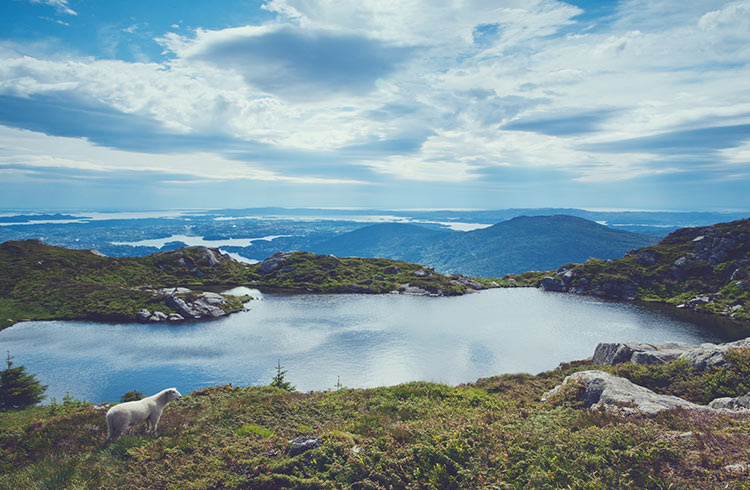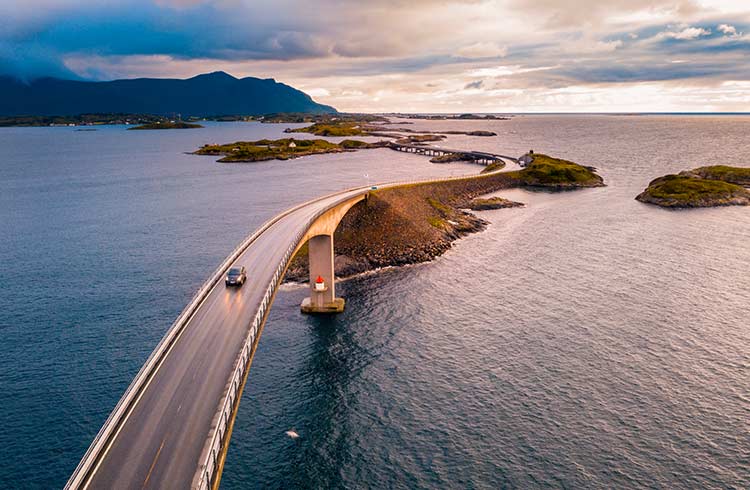Adventure in Norway: Wildlife and Wilderness Safety
Learn how to observe wildlife from a safe distance and stay safe in Norway's incredible wilderness whether you're in Svalbard or Nordland, here's what you need to know.
 Photo © Getty Images/Jekaterina Nikitina
Photo © Getty Images/Jekaterina Nikitina
Enjoy Norway's incredible scenery safely with these tips.
Wildlife in Norway
Deer can be seen all over Norway, particularly in the country areas and tundra. In deer country there is usually more than one deer around, so if you see one about to cross the road you are driving on, be alert for the second as they are usually not far away, and can do a significant damage to your car if you hit one.
Drivers in Western Norway should be alert to red deer jumping onto the highway in late autumn and winter, often without warning. There are special signs at some of the more common crossing points to alert drivers.
Moose and Elk are also known for running out onto roads around dusk and dawn and drivers should exercise caution at these times. The elk is at its most active after heavy snowfall, at a full moon and at twilight and dawn. Drivers in Northern Norway are likely to see reindeer that also wander onto the roads and sometimes shelter in mountain tunnels, appearing suddenly. Sheep and goats are also found walking on roads and can be a hazard to traffic.
Norway has around 50 wolves which are rarely a problem for visitors. As there are only 50 or so brown bears in Norway visitors are unlikely to see one. Walkers in Northern Norway are likely to be pestered by swarms of blackfly and mosquitoes which emerge from the tundra bogs and lakes during summer. It is advisable to wear long trousers and shirts and avoid exposing the skin. Head nets are essential and if camping it is best to use mosquito netting.
Norway has one venomous snake which could be a hazard to walkers. This is the European Adder (hoggorm) which has a distinctive v shaped pattern on its back. The adder can be found all over Norway except the Arctic and its bite is rarely life threatening.
Polar bears on Svalbard
Svalbard is located halfway between the Norwegian mainland and the North Pole in the Arctic Ocean. This Arctic fairyland of Svalbard is made up of glaciers, mountains, icy fjords, snow and polar bears.
Around 2,500 locals share the islands with roughly 3,000 polar bears. As cute and fluffy they may appear, they can pose a risk to humans. Polar bears can move at an incredible speed and are not to be underestimated. They cannot be outrun by humans and are far more unpredictable than the European brown bear.
With climate change threatening polar bear habitat, including shrinking pack ice and the number of tourists visiting Svalbard annually increasing, interactions between bears and humans is inevitable. It is vital to take precautions when visiting this part of Norway.
In Svalbard, making contact with polar bears is strictly forbidden as it can jeopardise the safety of both humans and the bears themselves. Bears should not be approached and should also not be chased on snowmobiles or other vehicles as they will overheat quickly. Anyone traveling outside the main town area of Longyearbyen has to know how to use or travel with someone who knows how to use a gun and carry one in case there is an encounter with a polar bear. Longyearbyen is the only safe place to walk freely without the need for a gun, however on the odd occasion, bears have been seen in town. Authorities have coordinated measures in place to sedate and relocate a bear in another part of the island should it wander into town.
If visitors are camping they need to carry flares and use trip wires around the perimeter of their camp. Any food and waste must be at least 320ft (100m) away from a tent, and stored in a way that it can be seen from the tent flap. In 2015, a camper from the Czech Republic was attacked in their tent by a polar bear, fortunately only sustaining minor injuries.
Svalbard is 60% glacier, and therefore any visitors must report where they are going to the Local Governor.
What are the seasons in Norway?
Winter runs from December to February, late winter/spring is March to May, their version of summer is June to August, and fall falls during September to November.
Wilderness safety tips for Norway
Venturing into the Norwegian mountains and wilderness requires preparation, no matter what time of the year you are visiting Norway. The conditions are harsh and the weather can suddenly change.
When driving across the mountains it is very important to have a full tank of fuel, warm clothing, snow chains and food. Even on a hot day the weather can change and it is essential to have waterproof clothing and warm layers. Always inform someone where you are going and your route.
Listening to weather warnings is essential in Norway. Local hotels can advise on weather conditions and it is possible to rent equipment in Norway. Visitors should be aware that in Norway there is an expectation that a person can manage on their own in the wilderness and therefore you will need to prepare wisely.
Public shelters are crucial for safety if there's a sudden blizzard. Research what facilities mark the trails you are hiking prior to departure.
Hypothermia and frostbite risk in Norway's wilderness
Hypothermia and exposure are big killers in the Norwegian wilderness, which is why it is vital to take time preparing for any eventuality. Make sure you can recognise the early signs of hypothermia which are loss of judgment, shivering and clumsiness. It's important to get warm at the first sign of hypothermia otherwise the condition progresses to confusion, apathy and coma which leads to death. You can prevent further heat loss by sheltering somewhere and staying dry, drinking hot sweet fluids and getting into some dry clothing. Sharing body warmth is an excellent way of preventing hypothermia and wearing a hat as a substantive amount of body heat can be lost form the head.
Frostbite is another hazard of travelling in Norway's wilderness regions and starts as a white numb area of skin or a frost nip. If the skin is not warmed it will develop blisters and turn black. It is very important to ensure you have a high calorie intake and wear warm clothing to prevent frostbite. Read these tips on how to treat and avoid frostbite.
Related articles
Simple and flexible travel insurance
You can buy at home or while traveling, and claim online from anywhere in the world. With 150+ adventure activities covered and 24/7 emergency assistance.
Get a quote
2 Comments